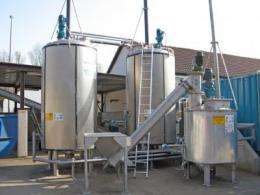Electricity from straw

Researchers have developed the first-ever biogas plant to run purely on waste instead of edible raw materials -- transforming waste into valuable material. The plant generates 30 percent more biogas than its predecessors. A fuel cell efficiently converts the gas into electricity.
"Corn belongs in the kitchen, not in biogas facilities" - objections like this can be heard more and more frequently. They are protesting against the fermentation of foodstuffs in biogas plants that generate electricity and heat. One thing the opponents are afraid of is that generating electricity in this way will cause food prices to escalate. In collaboration with several small and medium-sized enterprises, research scientists at the Fraunhofer Institute for Ceramic Technologies and Systems IKTS in Dresden have developed the first-ever biogas plant that works entirely without edible raw materials.
"In our pilot plant, we exclusively use agricultural waste such as corn stalks - that is, the corn plants without the cobs. This allows us to generate 30 percent more biogas than in conventional facilities," says IKTS head of department Dr. Michael Stelter. Until now, biogas plants have only been able to process a certain proportion of waste material, as this tends to be more difficult to convert into biogas than pure cereal crops or corn, for instance.
This is not the only advantage: The time for which the decomposing waste material, or silage, is stored in the plant can be reduced by 50 to 70 percent. Biomass is usually kept in the fermenter, building up biogas, for 80 days. Thanks to the right kind of pre-treatment, this only takes about 30 days in the new plant. "Corn stalks contain cellulose which cannot be directly fermented. But in our plant, the cellulose is broken down by enzymes before the silage ferments," Stelter explains.
The researchers have also optimized the conversion of biogas into electricity. They divert the gas into a high-temperature fuel cell with an electrical efficiency of 40 to 55 percent. By comparison, the gas engine normally used for this purpose only achieves an average efficiency of 38 percent. What is more, the fuel cell operates at 850 degrees Celsius. The heat can be used directly for heating or fed into the district heating network. If the electrical and thermal efficiency are added up, the fuel cell has an overall efficiency of up to 85 percent.
The overall efficiency of the combustion engine is usually around 38 percent because its heat is very difficult to harness. The researchers have already built a pilot plant with an electricity output of 1.5 kilowatts, enough to cover the needs of a family home. The researchers will present the concept of the biogas plant at the Hannover-Messe on April 20 to 24. In the next phases of the project, the scientists and their industrial partners plan to gradually scale up the biogas plant to two megawatts.
Source: Fraunhofer-Gesellschaft





















